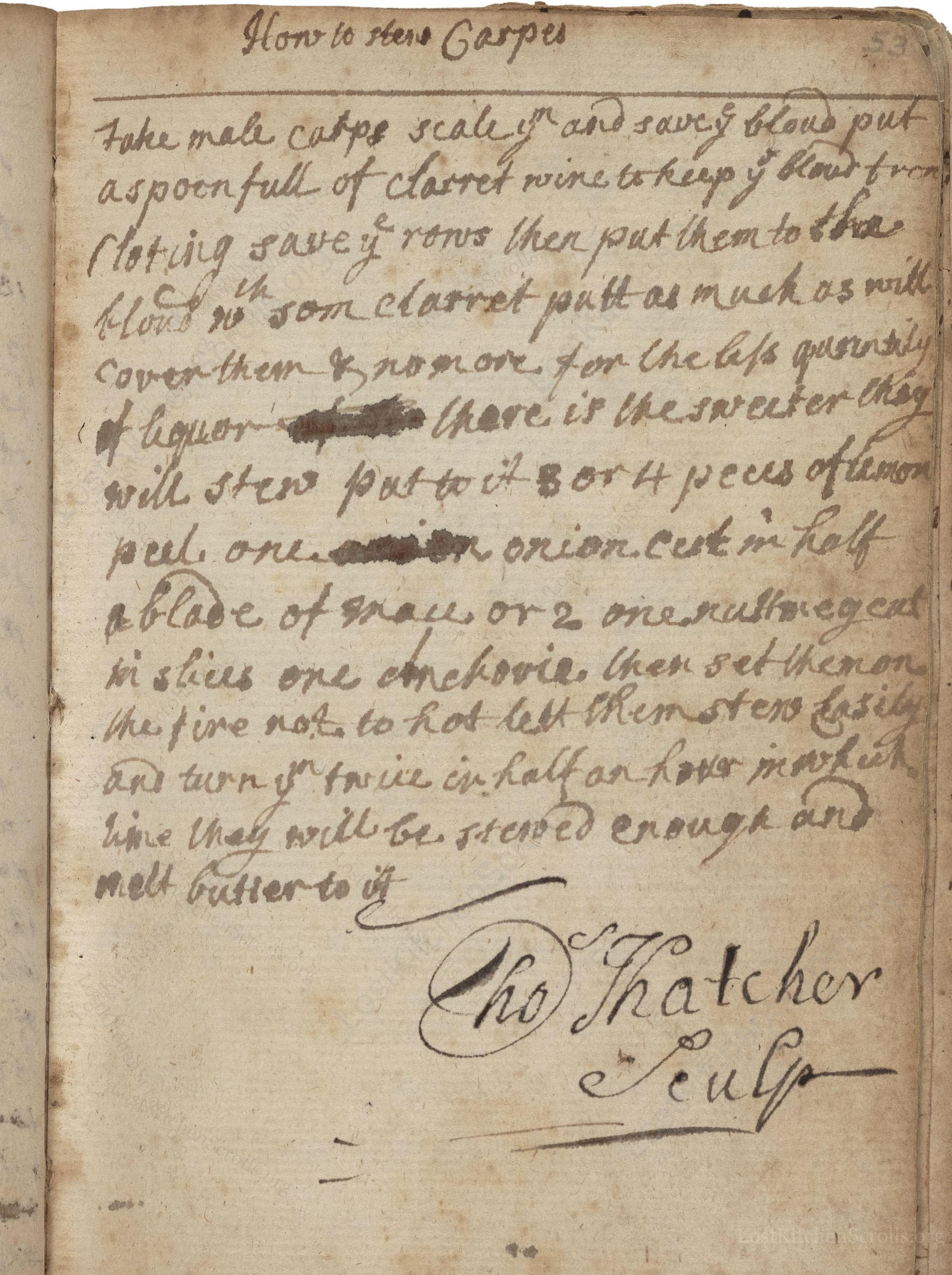How To Stew Carpes
From the treasured pages of Medicinal and cookery recipes of Mary Baumfylde
Written by Mary Baumfylde

How To Stew Carpes
"Take male carps scale & savey bloud put a spoone full of claret wine to keep ye bloud from Cloting savey ye roes then put them to tha bloud & som claret putt as much as will Cover them & no more. for the less quantity of liquor there is the sweeter they will stew. put to it 3or 4 peces of lemon peel. one onion cut in half a blade of mace or 2 one nutmeg cut in slices one anchovie. then set then on the fire not to hot lett them stew Easily and turn ye twie in half an hour in which time they will be stewed enough and melt butterr to it"
Note on the Original Text
Historical recipes are characteristically sparse: measurements are broad or absent, and much is left to the cook's knowledge. Instructions highlight key flavors and processes but expect the reader to interpret finer details, like timing, quantities, and temperatures. Spelling and word choice reflect the era (e.g., 'savey' for 'save', 'ye' for 'the', 'cloting' for 'clotting'). Anchovy and mace would, at the time, have been exotic flavorings. The inclusion of blood was a common thickening agent in 17th-century English cookery, especially with freshwater fish.

Title
Medicinal and cookery recipes of Mary Baumfylde (1626)
You can also click the book image above to peruse the original tome
Writer
Mary Baumfylde
Era
1626
Publisher
Unknown
Background
A sumptuous journey into early 17th-century English cookery, this delightful volume offers a tantalizing glimpse into the recipes, flavors, and culinary secrets that once graced aristocratic tables. Prepare for a taste of history, presented with wit and wisdom!
Kindly made available by
Folger Shakespeare Library
This recipe stems from the early modern English culinary tradition, specifically found in a cookbook attributed to Mary Baumfylde from the 17th to mid-18th century. The dish showcases both the value placed on freshwater fish such as carp in noble and upper-class households and their affinity for complex, warmly spiced stews that combined sweet, savory, and tangy flavors. Claret wine, mace, nutmeg, and anchovies were sought-after ingredients, demonstrating the reach of colonial and continental trade by the 1600s. Recipes like this illuminate both the kitchen practices and the palate of early modern England.

The fish would have been prepared on a wooden chopping block using a strong, sharp knife for scaling and slicing. A large shallow stew pan or pipkin (an early earthenware pot) was placed over a wood or charcoal fire, managed for gentle, consistent heat. A wooden spoon was used for stirring and occasionally turning the fish. A small pan for melting butter and basic kitchen cloths for straining or wiping were also typical of the period.
Prep Time
30 mins
Cook Time
30 mins
Servings
4
We've done our best to adapt this historical recipe for modern kitchens, but some details may still need refinement. We warmly welcome feedback from fellow cooks and culinary historians — your insights support the entire community!
Ingredients
- 2 male carps (about 2.2 lbs each), scaled
- Blood reserved from the carp (substitute with fresh fish blood if possible, or omit if unavailable)
- 1 tablespoon (0.5 fl oz) claret wine (dry red wine, as substitute)
- Carp roes, if available (optional)
- 1 cup (8 fl oz) claret wine (dry red wine)
- 3–4 strips lemon peel
- 1 medium onion, cut in half
- 1–2 blades mace
- 1 whole nutmeg, thinly sliced (or 1/2 teaspoon ground nutmeg as substitute)
- 1 anchovy fillet, rinsed and chopped
- 3.5 tablespoons (1.75 oz) butter, melted
Instructions
- Begin by cleaning two male carps (about 2.2 lbs each), scaling them and reserving the blood.
- To prevent the blood from clotting, immediately stir in about 1 tablespoon (0.5 fl oz) of claret wine.
- If using roe, set them aside with the blood for additional richness.
- Place the blood (and roe, if using) in a shallow pan and just cover with claret wine (about 1 cup; enough to submerge the blood and fish but not more, as less liquid yields a richer stew).
- Add 3–4 strips of lemon peel, one onion (halved), 1–2 blades of mace, one nutmeg sliced thinly, and a single anchovy fillet (rinsed and chopped).
- Arrange the carp in the pan.
- Heat gently over a low flame; do not let it boil.
- Gently turn the fish once or twice over 30 minutes, until tender and the sauce slightly thickened.
- Melt some butter (about 3.5 tablespoons or 1.75 oz) and serve drizzled over the fish.
Estimated Calories
400 per serving
Cooking Estimates
Preparing the ingredients, including cleaning and scaling the fish, takes about 30 minutes. Cooking on low heat takes another 30 minutes. Each serving is estimated to contain about 400 calories, assuming the dish serves 4 people.
As noted above, we have made our best effort to translate and adapt this historical recipe for modern kitchens, taking into account ingredients nowadays, cooking techniques, measurements, and so on. However, historical recipes often contain assumptions that require interpretation.
We'd love for anyone to help improve these adaptations. Community contributions are highly welcome. If you have suggestions, corrections, or cooking tips based on your experience with this recipe, please share them below.
Join the Discussion
Rate This Recipe
Dietary Preference
Main Ingredients
Culinary Technique
Occasions

Den Bockfisch In Einer Fleisch Suppen Zu Kochen
This recipe hails from a German manuscript cookbook compiled in 1696, a time whe...

Die Grieß Nudlen Zumachen
This recipe comes from a rather mysterious manuscript cookbook, penned anonymous...

Ein Boudain
This recipe comes from an anonymous German-language manuscript cookbook from 169...

Ein Gesaltzen Citroni
This recipe, dating from 1696, comes from an extensive anonymous German cookbook...
Browse our complete collection of time-honored recipes



